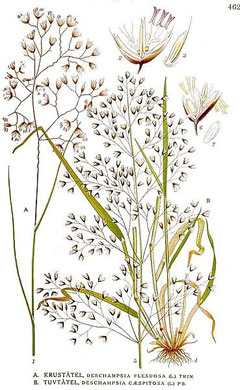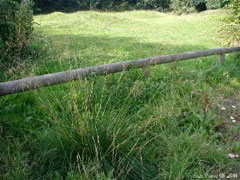 |
|
|
 |
| http://commons.wikimedia.org/wiki/User:MGA73bot |
Translate this page:
Summary
Bloom Color: Yellow.
Main Bloom Time: Late spring. Form: Rounded.
Physical Characteristics

 Deschampsia_caespitosa is an evergreen Perennial growing to 1 m (3ft 3in) by 0.5 m (1ft 8in) at a medium rate.
Deschampsia_caespitosa is an evergreen Perennial growing to 1 m (3ft 3in) by 0.5 m (1ft 8in) at a medium rate.
See above for USDA hardiness. It is hardy to UK zone 5. It is in leaf all year, in flower from June to August. The species is hermaphrodite (has both male and female organs) and is pollinated by Wind.
Suitable for: light (sandy), medium (loamy) and heavy (clay) soils and can grow in heavy clay soil. Suitable pH: mildly acid, neutral and basic (mildly alkaline) soils and can grow in very acid soils.
It can grow in semi-shade (light woodland) or no shade. It prefers moist or wet soil.
UK Hardiness Map
US Hardiness Map
Synonyms
Aira caespitosa.
Plant Habitats
Edible Uses
Seed[105, 161, 177, 257]. No further details are given, though it is likely that the seed was ground into a flour and used as a cereal. However, the seed is quite small and its use would be rather fiddly[K].
References More on Edible Uses
Medicinal Uses
Plants For A Future can not take any responsibility for any adverse effects from the use of plants. Always seek advice from a professional before using a plant medicinally.
None known
References More on Medicinal Uses
The Bookshop: Edible Plant Books
Our Latest books on Perennial Plants For Food Forests and Permaculture Gardens in paperback or digital formats.

Edible Tropical Plants
Food Forest Plants for Hotter Conditions: 250+ Plants For Tropical Food Forests & Permaculture Gardens.
More

Edible Temperate Plants
Plants for Your Food Forest: 500 Plants for Temperate Food Forests & Permaculture Gardens.
More

More Books
PFAF have eight books available in paperback and digital formats. Browse the shop for more information.
Shop Now
Other Uses
Plants form impenetrably dense clumps and when planted close together in drifts make an excellent ground cover[200].
Special Uses
References More on Other Uses
Cultivation details
Landscape Uses:Border, Container, Ground cover, Massing, Rock garden, Specimen, Woodland garden. Prefers a humus-rich acidic soil[200] but it succeeds in most soils[1]. It prefers a soil on the heavier and wetter side[1], but it also grows in drier soils[162]. Does well on damp or wet banks or in open woodland[1, 162]. There are several named varieties, selected for their ornamental value[200]. Special Features:
Attractive foliage, Naturalizing, Suitable for dried flowers, Attractive flowers or blooms.
References Carbon Farming Information and Carbon Sequestration Information
Temperature Converter
Type a value in the Celsius field to convert the value to Fahrenheit:
Fahrenheit:
The PFAF Bookshop
Plants For A Future have a number of books available in paperback and digital form. Book titles include Edible Plants, Edible Perennials, Edible Trees,Edible Shrubs, Woodland Gardening, and Temperate Food Forest Plants. Our new book is Food Forest Plants For Hotter Conditions (Tropical and Sub-Tropical).
Shop Now
Plant Propagation
Seed - sow in situ in spring or autumn[162, 175, 200]. Only just cover the seed[175]. Germination usually takes place within 2 - 3 weeks at 13°c[175]. If seed is in short supply it can be sown in a cold frame in spring, pricked out into individual pots as soon as it is large enough to handle and planted out in early summer.
Other Names
If available other names are mentioned here
Native Range
Coming Soon
Weed Potential
Right plant wrong place. We are currently updating this section.
Please note that a plant may be invasive in one area but may not in your area so it’s worth checking.
Conservation Status
IUCN Red List of Threatened Plants Status :

Growth: S = slow M = medium F = fast. Soil: L = light (sandy) M = medium H = heavy (clay). pH: A = acid N = neutral B = basic (alkaline). Shade: F = full shade S = semi-shade N = no shade. Moisture: D = dry M = Moist We = wet Wa = water.
Expert comment
Author
(L.)P.Beauv.
Botanical References
17200
Links / References
For a list of references used on this page please go here
Readers comment
| Add a comment |
|
If you have important information about this plant that may help other users please add a comment or link below. Only comments or links that are felt to be directly relevant to a plant will be included. If you think a comment/link or information contained on this page is inaccurate or misleading we would welcome your feedback at [email protected]. If you have questions about a plant please use the Forum on this website as we do not have the resources to answer questions ourselves.
* Please note: the comments by website users are not necessarily those held by PFAF and may give misleading or inaccurate information.
To leave a comment please Register or login here All comments need to be approved so will not appear immediately.
|
Subject : Deschampsia_caespitosa
|
|
|
|